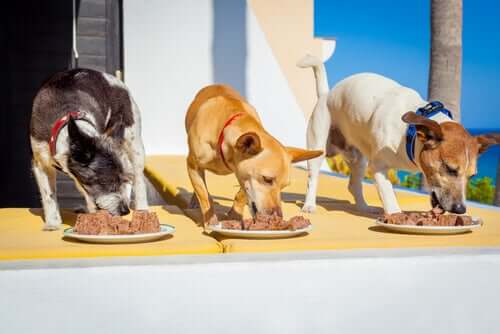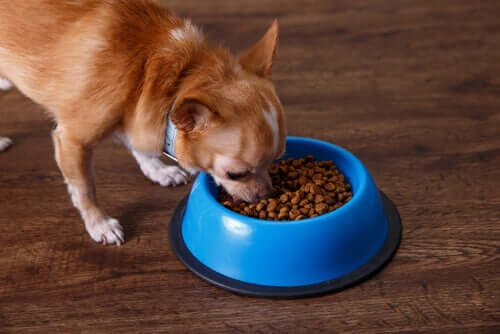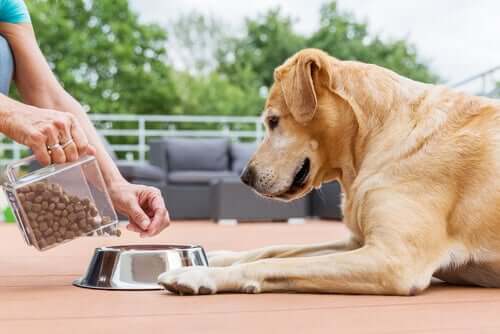How to Calculate the Ideal Portions for Your Dog

Food time is one of those parts of the day that every pet waits for anxiously. It’s your responsibility, though, to make sure they eat healthily, and in the right proportions. So, if you still have any doubts about your dog’s diet, we’re going to teach you how to calculate the ideal portions for your dog.
What factors are at play in diet?
Just like human beings, every single animal has basic dietary needs. Focusing specifically on dogs, there are some conditions that can tell you lots of different things, like the best type of food for it. Those conditions are easy to outline and determine. Here they are:
- Breed, size, and weight. These are all fundamental factors when it comes to calculating the ideal portions for your dog.
- Activity level: how much your dog should eat depends a lot on how active it is. There’s also a link between this and breed.
- Age

Below, we’re going to look into each and every one of those conditions. Knowing how they work can be a big help in calculating the ideal portions for your dog.
The ideal portions for your dog based on breed, size, and weight
Like we said earlier, these three things are the most important factors in figuring out how much food your dog needs. It probably comes as no surprise that size plays a part in this. But what you might not have known is that small dogs actually use more energy, proportionally, than big dogs. Don’t go adding more food to their bowl yet, though!
As far as weight and breed are concerned, you should take a look at the charts that dog organizations put up and update every so often. They’ll provide you with a guide for your dog’s weight based on its breed, and tell you how much food it needs.
Let’s take tiny dogs as our first example. If you have a breed that’s under 6 pounds, like a chihuahua, its daily intake should be something like 2-3 ounces.

However, if you have a dog that’s over 100 pounds, like a Newfoundland, it should have no less than 1 pound of food per day.
Ideal portions for your dog based on its activity level and age
How much energy your dog has, and uses every day, definitely plays a part in its diet, too. A dog with a high activity level (whether from long walks or other activities) needs a lot more calories. That means you need to feed it more. This isn’t the case with sedentary dogs.
Lastly, age is also related to your dog’s ideal portions. In this case, it’s about both quantity and quality. A dog’s ideal diet varies as it ages. For example, once a puppy has been weaned, the best food for it is something with a high calorie (energy) content. You should also feed it four times a day.
As it gets older, the type of food and how often it needs to eat will keep changing all the way into old age. An older dog needs a diet much lower in fat, and in smaller quantities. Because old dogs tend to move around a lot less, this helps to prevent them from becoming overweight.

Some extra tools to calculate the ideal portions for your dog
If you’re still feeling unsure, don’t worry! There are lots of different resources and tools out there to help you figure out your pet’s diet. One of the simplest things you can do is look at the manufacturers’ instructions on the food’s packaging. There’ll be all kinds of detailed information about how much food to give your dog and what type.
It’s also good to have a measuring cup for your dog’s food. If you know how much it needs per meal, then this will help you make sure you’re giving it just the right amount. Technology is here for you, and your pets, too. There are web programs that can help you count calories for your dog to ensure a healthy intake.
Last, but not least, going to your vet is always a good option. They already know your dog, and its specific dietary needs. So, what better person is there to help you figure out its diet?
All cited sources were thoroughly reviewed by our team to ensure their quality, reliability, currency, and validity. The bibliography of this article was considered reliable and of academic or scientific accuracy.
- Domínguez, M. S. G., & Bernal, L. (2011). Diagnóstico y manejo de la obesidad en perros: una revisión. Revista CES Medicina Veterinaria y Zootecnia, 6(2), 91-102.
- Rohlf, V. I., Toukhsati, S., Coleman, G. J., & Bennett, P. C. (2010). Dog obesity: can dog caregivers'(owners’) feeding and exercise intentions and behaviors be predicted from attitudes?. Journal of Applied Animal Welfare Science, 13(3), 213-236.
This text is provided for informational purposes only and does not replace consultation with a professional. If in doubt, consult your specialist.